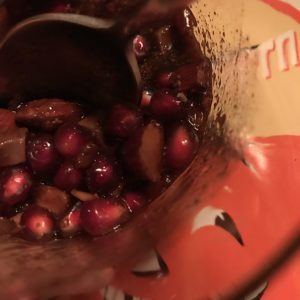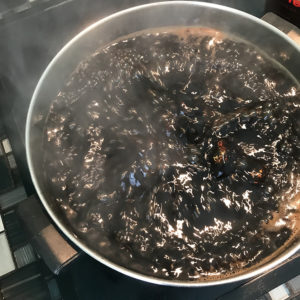Sometimes, very occasionally, I read earlier chapters of this blog in preparation to write new ones, and it seems to me that I can’t say things any better than I did in the past. Today’s post is one such case. Most of the paragraphs below were written for Martinmas 2019. I’ve improved a few things, I think, but for the most part, here is that chapter as it appeared last year. It is the time now of closure for our mysterious autumnal days each year when we remember those who have come and gone before. Through memory, we look back, and yet we are very much present during this time. Perhaps, then, this bit of looking back and looking ahead is more fitting than I thought. –– John
It’s November, and very soon, Mom will wake up one morning and decide it is time to make u cutto. She’ll put her big pot on the stove, pour in the ingredients, and it will simmer all day long, and into the night. U cutto is what we call it in our Lucerine dialect from Apulia: “oo coot-oh.” In proper Italian, it would be vin cotto, or mosto cotto: cooked wine, or cooked must. It is a syrupy concoction that we use in all sorts of sweets at the end of the year. It’ll show up in Christmas cookies, and last year’s mosto cotto made an appearance at All Souls Day in a dessert distinct to my grandparents’ region of Apulia that is made just for that night. My grandparents used to pour it over freshly fallen snow as a treat for the kids. It is, at its most basic, what’s left of the grape must after winemaking, boiled down with sugar to a reduction. The aroma fills every corner of the house as it simmers through the day, as the brew reduces to its proper consistency. It is prized by my people, this autumnal concoction so distinctive to Apulia: its own sort of black gold.
U cutto would traditionally be made around the Nativity of Mary, which was in September, or around Martinmas, which is today. Mom doesn’t usually even think about these things, though: when she makes it, it is simply time to make it. It’s autumn, and her thoughts have begun shifting to holiday preparations, and making u cutto is a big preparation, and a time-consuming one. When she makes it, it is more instinctual than anything else: it is November, and this is what we do in November… a culinary tradition handed down from time immemorial. Her mother made u cutto, as certainly did her grandmothers, and their mothers before them.
Martinmas has a lot to do with wine, anyway, for it is time for the first tasting of the wine that was put up to ferment in September. It’s also when the young new Beaujolais wines of France are released. This has to do with timing and with St. Martin of Tours, who lends his name to Martinmas, being a patron saint of winemakers. It is also the last big religious feast before Advent, that time of preparation for Christmas. In earlier days, Advent was a season of fasting, and so Martinmas was a very big deal, a chance to indulge. Traditional Martinmas foods include goose and turkey, and also chestnuts and very hard biscotti, some of which are baked not just twice but three times. The extra baking makes them hard as rocks, but with good reason: Biscotti di San Martino are meant to be dunked in that new wine that we’re drinking on his day.
In the parts of Europe that most thoroughly celebrate St. Martin’s Day, it is often a time of warmer weather, the last bit of it before the full onset of winter. Kind of like Indian Summer in America, it’s known in Italy, for instance, as l’estate di San Martino (St. Martin’s Summer). But this mild weather tends to be fleeting. Colder nights lie ahead and with Martinmas we find ourselves, by traditional reckoning of time, at the natural start of winter. It is, until Yuletide, a time of increasing darkness. The living world continues its process of shutting down and receding into itself: going underground. Trees are no longer growing above, but roots below the surface still are growing. And so the connexions are strong, these darkening days, between the world of the living and the underworld of the dead.
Of course we honored these days of the dead at the start of the month with Hallowe’en and All Saints and All Souls. But the connexion of Martinmas to the days of the dead is just as strong, through memory. Before the change to the Gregorian Calendar, the 11th of November was Samhain, the Celtic New Year. Another name for Martinmas is Hollantide, and just as Hallowe’en is a corruption of the words All Hallow’s Eve, so is Hollandtide, which comes from Hallowtide: the time of the sacred, the holy––those who have gone before. Many of our contemporary Hallowe’en traditions come out of Hollantide traditions: the carving of turnips (replaced by pumpkins here in America) into Jack o’Lanterns and the going door to door in search of soul cakes, which has evolved into the trick-or-treating we know today. The day is also a traditional weather marker: If ducks do slide at Hollantide, At Christmas they will swim. / If ducks do swim at Hollantide, At Christmas they will slide. / Winter is on his way / At St. Martin’s Day.
Finally, it is, of course, Veterans Day, when we honor all who have served in the military. The day was formerly known as Armistice Day, for it was on Martinmas in 1918 that the treaty ending what would later be known as World War I was signed. The day is known as Remembrance Day in many places, but here in the US, Veterans Day became the day’s official name in 1954.
St. Martin also was a veteran. He served in the Roman army, until his conversion to Christianity and to pacifism, for which he was imprisoned. Upon his release, he went to France and founded a monastery. The best known legend about good St. Martin is his happening upon a shivering drunken man on a cold winter’s day. Martin tore his own cloak in two and gave one half to the drunken man to warm him. The legend makes St. Martin a patron saint not just of winemakers, but also of those who love wine (including those who love it too much).
And so we continue turning inward at this time of year, gathering in, preparing for winter. What’s a good way to mark this Martinmas evening? Certainly with wine. Light a fire while you’re at it. The Celts would have lit huge bonfires on Samhain to welcome in the new year, and in our case, a small celebration involving a fire in the hearth or in the fire pit in the back yard is just as good, made even better with mulled wine and good company. Good St. Martin himself would have it no other way… especially if the year’s new cutto––the mosto cotto––is already brewed and bottled and being kept cool in the fridge. Our time of Christmas preparation lies ahead. For now we pause and delight in the small things of this earth.
Images: At top, Cici Cutto (pronounced “chee-chee coot-oh”), the traditional dessert for I Morti, or All Souls Night, that comes from my grandparents’ city of Lucera in Italy. It is a strange concoction of cooked whole wheat berries, pomegranate, chopped toasted almonds, and chopped chocolate. U cutto, infused with cloves and cinnamon, is poured over it. Second photo: Mamma’s pot of u cutto simmering on the stove, to be later packed in jars and stored in the refrigerator, ready for use on all sorts of wonderful things. Like most seasonal delicacies, she makes it just once each year.
CHRISTMAS STOCK-UP SALE!
Use discount code STREETFAIR when checking out at our catalog, and we’ll take $10 off your purchase of $75 or more, plus we’ll ship your domestic order for free. That’s a savings that totals $18.50, which is not so bad at all! Many fine things to choose from: traditional sparkly Advent calendars from Germany and handmade daily Advent candles from England to help mark daily the transition to Christmas; winter incense and traditional wooden artisan goods for Christmas from Germany and Sweden and Italy, including ornaments and incense burners and pyramids and nutcrackers (some vintage GDR!); sparkling painted tin ornaments and nativity sets from Mexico (one of them is a pop-up!), and our popular embroidered protective face masks from Chiapas (they make fine stocking stuffers); handmade soaps for Hanukkah and Christmas from our local soap maker Kelly Sullivan; fir balsam pillows that smell for all the world just like Christmas itself––they are from the Sabbathday Lake Shaker Community in Maine, who also offer you bags of their homegrown culinary lavender and their full selection of herbal teas and culinary herbs; letterpress printed books and broadsides that we make here in our workshop… oh and how about a Day of the Dead themed nativity set handmade in Mexico (one of our most popular items ever)?
Take a look around our catalog and see if we can’t help fulfill some of the shopping on your list (while saving you a bit of cash, too). Your transactions translate into real support for a very small company AND for other small companies, real families, local friends and family, and as for the Sabbathday Lake Shaker Community, well… they are the only remaining active Shaker Community anywhere, and America’s oldest religious community, established in 1783. All of the folks we work with are deserving of your support on this transactional basis, especially now, in strange, more challenging times. Companies like Amazon are enjoying record-breaking sales and profits right now… but it’s the little guys that are struggling to make ends meet. The small companies and artisans we work with appreciate every sale, like you wouldn’t believe. It’s just like voting. Purchasing what they make is your vote for them; it means you believe in what they do. Please consider supporting what we do so we can continue to support the artisans we know. And please take a look around at the small businesses in your area, too. Especially small family-run restaurants. They need your business to make it through to the other side of this.
Here’s a link to our catalog. Remember the discount code STREETFAIR at checkout… our nod to all the wonderful local celebrations that are canceled this year (like the Sankta Lucia Festival by SWEA: the Swedish Women’s Educational Association in Boca Raton, and the Christkindlmarkt at the American German Club in Lantana). We thank you for your support!




